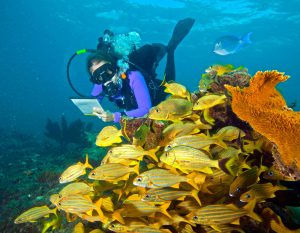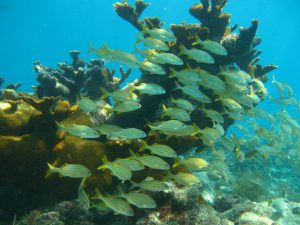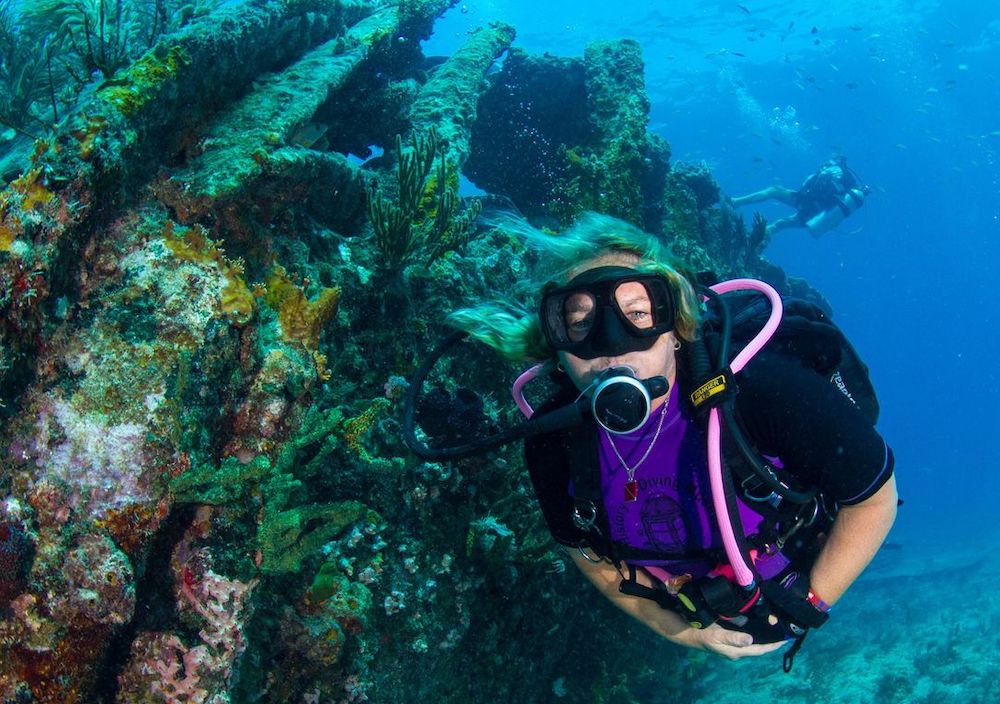It’s January. In a few weeks, that pesky groundhog is scheduled to see his shadow — or not. But meantime, whether you’re stuck in the snow belt or the “gray skies belt,” chances are you’re tired of indoor confinement and craving warmth and outdoor enjoyment.

In the Florida Keys, recreational divers can connect with and help protect the ocean realm in many ways. Here, a diver is shown volunteering by participating in a fish count, collecting valuable information for environmental organizations. (Photo by Nathan Brown)
You might even be craving an escape to the pristine blue waters of the Florida Keys where (in these days before the COVID-19 vaccine is widely available) there are vast open spaces where it’s easy to maintain proper social distance.
One of nature’s greatest wonders is a living coral reef — and the only one in the continental United States parallels the Keys. That means the island chain is an unbelievable place to learn to scuba dive.
Check out the facts here. And when you’re ready to travel, consider heading to Florida’s southernmost islands to “take the plunge.”
WHO can learn to dive?
Any healthy, active person as young as age 10 can learn and enjoy the adventurous sport of scuba diving.
WHAT certification classes are available?
If you’re seeking entry-level certification, allow three to five days for training. Also called “open water” certification, this requires classroom work and pool training, followed by one or more open-water dives at the reef.
Once you pass a knowledge test and complete the required number of dives, you become a certified recreational scuba diver — eligible to rent dive gear and book dive trips with most operations worldwide.

Once certified, divers can explore the Florida Keys National Marine Sanctuary, an environmental treasure that protects the waters surrounding the entire island chain.
Generally, basic certification covers depths to about 60 feet.
Short on time? Use an online program to complete classroom work at home — dealing with concepts such as basic physics and physiology, and the importance of monitoring time and depth during a dive. (For some online courses, students must be at least 13 years old.)
Once that’s done, you can schedule time in the Keys to complete your water skills during open-water dives … and explore the reef.
HOW MUCH will it cost?
Scuba is an investment in adventure. The price varies, but a basic certification course generally runs a few hundred dollars.
When you’re researching professional dive operations, make sure you consider value versus price, what rental equipment is included in the cost, and whether or not you receive personalized, one-on-one service and training.
WHERE do students receive their dive training?

Diving the coral reef in the Florida Keys National Marine Sanctuary can be an amazing adventure. (Photo by Bob Care, Florida Keys News Bureau)
The entire Keys are an unparalleled dive destination. Some of America’s very first businesses offering recreational dive training were opened in the island chain.
You can choose from dozens of dive operations staffed with working professionals. Local dive instructors actively teach and train each day — not just seasonally.
Click a region here to see available professional dive facilities: Key Largo, Islamorada, Marathon, Big Pine and the Lower Keys, and Key West.
WHEN are classes offered?
In the Keys (unlike other U.S. destinations), year-round subtropical weather and clear, warm seas make for an ideal learning environment virtually any time of year — which sure beats learning to dive in a cold, dark quarry or lake up north.
WHAT’S the “classroom” like?
Training usually is conducted in small groups, allowing personalized or even one-to-one attention.

The Keys’ underwater wonders are particularly spectacular along the coral reef tract near Key Largo’s John Pennekamp Coral Reef State Park — America’s first undersea preserve. (Photo by Frazier Nivens, Florida Keys News Bureau)
Training conditions at the Keys’ shallow barrier reef are nice and easy, with light currents and great underwater visibility. You’ll learn about ocean waves, marine life, beautiful corals and navigation around natural formations during a dive.
The reef lives in waters as shallow as five feet and as deep as 50 feet, but most reef divers log a maximum depth of 20 to 30 feet. Keys shallow diving means you can safely spend more time on the bottom exploring, and colors are brighter and more vibrant because more natural sunlight reaches shallow depths.
WHY dive the Keys?
The Keys attract some of the world’s most diverse species of fish, and you also can enjoy a “wreck trek” of venerable historic wrecks and ships intentionally sunk to create artificial reefs. These artificial reefs are home to a huge variety of corals and fish.
In fact, Keys sites offer divers — from recreational to expert — the chance to experience the underwater world’s beauty, diversity and serenity.
And especially these days, that’s awfully appealing.

